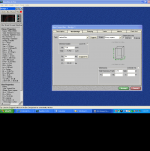I am using the latest version of of Bassbox Pro 6.0.22, I am trying to keep the baffle of the cabinet as small as possible so the speakers will take up less wall area. To do this I need to have multiple ports. Bassbox gives me the area for a single port (3/4" long, both ends flush) for the two 15" drivers (in the Vents/Other tab) as 112.8 sq. in. When I change to two vents it gives an area of 41.49 sq. in. which times two = 82.98 sq. in. Can someone tell me why the area is smaller with two ports? is this correct? With 4 ports it gives an area of 15.45 sq. in. which times 4 = 61.8 sq. in. I have attached a very crude drawing showing the port configuration I want. I am also listing the thiele parameters, and a screen shot of Bassbox Pro . the four ports in the corners are all the same size, the two ports between the woofers are two ports the same size as the corner ones put together to form one port twice the size as the corner ones on each side. Basically the same as 8 ports all the same size. I thought I could enter in 4 ports into Bassbox and just cut them in half diagonally and connect two of them together for the middle two. But Bassbox changes the total area. Any help on this would be appreciated.
Thanks, Kerry
Thanks, Kerry
Attachments
I don' think it's going to make that big of a difference. (Maybe someone else can help you with that software). Work with the surface area of the port x length, 4 or 8 ports isn't going to make that much of a difference, if you devide the 4 by 2 or join 2 of the 8 ports together in terms of final results, if the length, volume of the ports and tunning freq (Fb) it's the same. Maybe there are small changes with the thickness of the tubes used that's all in practical terms. Your final adjustments/testing will be much more important.
3/4" long ports don't contain enough air to not be "blown out" with 8mm Xmax.
The smaller ports have a higher aspect ratio, they tune lower with less open area.
You could minimize frontal area and use good size ducted ports by slot or "V" loading the speakers, the speakers facing each other.
Why are you tuning the box so high?
The smaller ports have a higher aspect ratio, they tune lower with less open area.
You could minimize frontal area and use good size ducted ports by slot or "V" loading the speakers, the speakers facing each other.
Why are you tuning the box so high?
I noticed something was not ok... 🙂3/4" long ports don't contain enough air to not be "blown out" with 8mm Xmax.
...
Why are you tuning the box so high?
V loading will not save any area since my baffle board is only 18.5 inches wide now. the ports have no wall thickness since they are just holes cut in the baffle board (which is why I want them to be correct from the start). I am tuning to 54 hz because I am using two BMS 18N862 18" drivers for subs, the crossover frequency between them will be 65hz, 24 db per oct. The 15" drivers are 18 Sound 15NLW9300.
I think it's because you're not keeping Fb constant. If you keep Fb constant and specify two ports (meaning you specify the area), then the length should be increase by the program accordingly to maintain your desired tuning frequency.
I have generally preferred multiporting. It's easier to get a high expansion ratio on any port flare you do, that way, and also you can distribute the locations around to spread modal behavior, both within the box and in the room.
Do your programs keep the area of all the ports combined the same as the area of a single port if the length remains constant?
The 18 Sound 15NLW9300 are 6.85" deep, a pair "V" loaded, like this:V loading will not save any area since my baffle board is only 18.5 inches wide now. the ports have no wall thickness since they are just holes cut in the baffle board (which is why I want them to be correct from the start). I am tuning to 54 hz because I am using two BMS 18N862 18" drivers for subs, the crossover frequency between them will be 65hz, 24 db per oct. The 15" drivers are 18 Sound 15NLW9300.
I00I
with a 5.5" front opening would only take up 18.5" width, leaving 15"x 18.5" of front panel space available for porting, or you could even reduce the vertical height if desired.
A large ducted port that will have plenty of volume and won't be "blown out" at high Xmax can easily be installed in that area.
Ducted ports are relatively easy to adjust, simply make them a little long, then reduce length if Fb is too low.
Fb can be determined by sweeping a sine wave tone, excursion will be least at Fb.
Ducted ports reduce the amount of reflected upper speaker response coming through the port compared to 3/4" depth holes, so less (if any) damping material needs to be used.
The more damping material, the less LF output.
The "V" plenum will cause a low mid peaking response (like a small horn) which can be EQd out, giving a bit more headroom than front mounted cones.
The reduced radiation area also will reduce comb filtering at the upper end of the speaker's bandwidth.
Art
- Status
- Not open for further replies.
- Home
- Loudspeakers
- Subwoofers
- Porting, 1 vs multi

